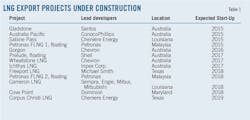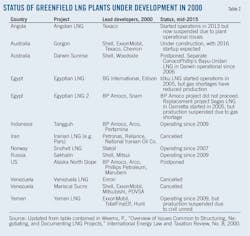Philip Weems
Kathryn Marietta
King & Spalding LLP
Houston
A clear regulatory foundation and close relationships with buyers are among the key aspects to successful development of an LNG liquefaction plant. LNG supply has surpassed demand, at least temporarily, and 13 new LNG export projects are either soon to come on line or will start LNG production in the next 4 years (Table 1). Competition between projects is fierce, the basis of future LNG prices uncertain, and capital costs steep. Not all proposed projects will realize success. This article examines a number of characteristics successful LNG export projects have shared.
Looking back
Of the 13 leading LNG export projects under development in 2000, only three are operating as originally planned (Table 2). Almost half of the projects (in Australia, Iran, Alaska, and Venezuela) were cancelled or postponed indefinitely and several (in Angola, Egypt, and Yemen) are experiencing major setbacks.
Predictions of industry experts, the signing of foundational agreements, and overall buzz in the press are often not good predictors of whether a project will be successful. Several major proposed LNG export projects once considered viable were, in the end, cancelled or postponed indefinitely for a variety of reasons (Table 3).
LNG export projects have numerous stakeholders and are complex technically, contractually, and structurally. A successful LNG export project receives host government support; is developed, marketed, financed, and built; and delivers LNG to markets on a continuing basis. Even successful LNG export projects, however, can:
• Be delayed for many years; even decades (e.g., Nigeria).
• Result in a company that originally discovered gas not being the one to benefit from LNG sales (Qatar).
• Have major issues over their lifetime, including gas reserves (Egypt) and technical issues (Norway).
Funding and construction do not equal success if the project is unable to deliver LNG on a continuing basis. The Angola LNG project, for example, started construction in 2008 and began exporting in 2013, only to be shut down soon thereafter due to reported design flaws and corrosion of nearly-new equipment.
Keys to success
Every LNG export project must aggregate sufficient advance LNG sales to allow an affirmative final investment decision (FID). FID kicks off construction and the beginning of large capital expenditures. Development will not proceed until target sales quantities are secured.
LNG sales contracts are typically 20-year commitments. Advance sales from a 5-million tonne/year (tpy) LNG plant (one train) are worth tens of billions of dollars. LNG buyers have numerous options in today's markets. One recent change in the North American market has allowed some projects to reach FID without securing advance sales. Tolling projects advance when capacity in an LNG train is contracted under long-term agreements. In some instances customers who will not consume the LNG commit to tolling even without having executed resale contracts with an end-user.
The North American tolling structure introduced a new methodology, creating different pricing dynamics for LNG produced in third-party tolling plants. The first LNG sales agreements using gas indices for determining price were also executed from a North American plant, Cheniere Energy's Sabine Pass.
LNG is still sold, to a great extent, on oil-based indices. But some buyers are pressuring sellers to index at least a portion of the sales to gas.
Project costs must meet economic requirements for both the liquefaction developer and the LNG buyer. The project ideally will be attractive to credit-worthy premium buyers with long-term gas demand. LNG prices in Asia historically have been twice as high as prices paid by long-term buyers in other regions. Japan, South Korea, and China combined to purchase over 60% of all LNG imported in 2014, according to the International Group of Liquefied Natural Gas Importers. Current projects sell into multiple markets in an effort to secure as many contracts with premium Asian buyers as possible.
Buyers at the same time look for reliable supply and are attracted to large reserves given the long-term nature of LNG sale and purchase agreements. Some fields experience steep declines, in some instances while local gas demand escalates (e.g., Egypt, Oman, and Bontang and Arun in Indonesia), compromising the seller's ability to supply agreed quantities. Force majeure and other contractual consequences may occur as resources are depleted.
Projects with a high percentage of liquids have typically been attractive, the sale of higher-priced condensates leveraging project profits. Gas supply quality is a consideration when attracting premium buyers. Coal seam gas and shale gas typically have lower gross heating values and are less attractive to many Japanese buyers.
Regulatory foundation
The operator's relationship with the host government is critical to project success and timing. Failure to obtain host government support will cause delay or cancellation (e.g., the decades-long battle between East Timor and Australia over sharing revenue from the Greater Sunrise fields). The operator must examine and understand the general legal, regulatory, contractual, and fiscal framework, as well as the interplay among these and the manner in which the project will be implemented.
LNG export projects also often require a separately negotiated legal and fiscal framework, established in some regions as an LNG Project Agreement and implemented through related legislation. Peru, for instance, enacted "The Law for the Promotion of Investments in Gas Processing Plants" and its regulations in 2004, followed by a Jan. 12, 2006, investment agreement between Peru LNG and Peru's government (OGJ Online, Jan. 13, 2006).
Investors will not risk exposure to changes in laws or tax systems which could adversely impact an LNG project's economics. The "Nigeria LNG (Fiscal Incentives, Guarantees, and Assurances) Act of 1990" provides certainty, as does Mozambique's December 2014 decree law on the Area 1 and Area 4 LNG projects and the project development agreement for Pacific Northwest LNG signed June 19, 2015, between Petronas and the Province of British Columbia, Canada. The more stable the agreement with the host government, the higher the likelihood of project success. Success also depends on agreeing with the host government to international arbitration of disputes, providing lenders, sponsors, and other stakeholders a higher degree of certainty should a dispute arise.
A successful LNG export project needs a competitive engineering, procurement, and construction (EPC) contract. Labor constraints are common when staffing during construction. Construction costs, including labor, for a typical LNG export project have roughly doubled in the last decade, growing even more in some cases and prompting project cancellation (e.g., Browse onshore liquefaction; OGJ, May 5, 2014, pp. 116-121).
The first two trains of the proposed Mozambique LNG project are estimated to cost $8-10 billion, with offshore wells and equipment another $5 billion. Additional costs, such as finance, push the potential total beyond $24 billion.
Buy-sell models, tolling models, and integrated project models are all viable at the start of a project. Unique characteristics will dictate the final structure and will tailor existing models to a given project. Lenders and buyers will carefully evaluate the commercial structure and the strength of the entire LNG value chain.
Inpex expects its $37-billion Ichthys LNG project in northern Australia to start up in 2017 (OGJ Online, Sept. 14, 2015). A project this costly is more likely to be financed if there is a predictable, clear, and coherent legal framework in place. A commercial structure that attracts financing ensures both a predictable long-term cash flow and take-or-pay contracts with credit-worthy buyers, and has survived risk analysis across the entire LNG value chain. A construction contract limiting construction phase risk, incorporating a well-managed fee structure with certainty as to schedule, and led by an experienced contractor or contractor group with a sound delivery history invites investment.
An experienced operator and a limited scope for operating-cost increases also inspire financiers. Although no LNG export project has so far defaulted on repayment of its project-financed loans, the recent inability of project-financed Egyptian projects to export (due to gas shortages) at the volumes needed to support debt service may lessen lenders' enthusiasm for the sector.
Buyers, partners
Premium buyers may insist on taking equity in the export project. Involving key buyers has become the norm in LNG export projects, the sense of partnership between seller and buyer aiding overall project success. For Freeport LNG's first liquefaction train, tolling customers Osaka Gas Co. Ltd. and Chubu Electric Power Co. Inc. had sufficient confidence in the project to invest about $1.24 billion in equity. This investment helped the project secure roughly $4.4 billion in debt financing for the first train from the Japan Bank for International Cooperation and six Japanese commercial banks, with the loans financed by the commercial banks insured by Nippon Export and Investment Insurance.
Early in project development, planners should carefully consider the percentage of participation in equity each buyer might have. It is not uncommon for premium buyers to have a greater equity interest than non-premium buyers. If the project's LNG is jointly marketed or marketed on a coordinated basis, the various buyers (who are also equity holders) may not want pricing disclosed to competitors.
Conflicts among partners can arise when different LNG portfolio priorities exist; i.e., competing projects or supply sources. Disagreement can affect project schedule and perhaps even success. The arbitration between Total and Oil Search over development of Papua New Guinea's Elk and Antelope gas fields is an example (OGJ Online, Mar. 2, 2015). Disagreement can also weaken the project's relationship with the host government. The host ideally is not both partner and regulator. If it plays both roles, contracts must carefully document where each begins and ends.
Differences in the timing of market demand and supply infrastructure can hamper an otherwise viable LNG export project. Demand comes in waves. Drivers of increased demand include:
• Existing buyers seeking additional or replacement LNG supplies.
• Buyers seeking to diversify supply sources to mitigate risk and ensure reliable supply.
• Buyers in new markets looking for large baseload LNG supplies.
The authors
Philip R. Weems ([email protected]) is co-head of King & Spalding's global energy practice and is based in Houston. Weems formerly served as managing partner of the firm's three offices in the Middle East and of the firm's office in Singapore. For the last 25 years he has specialized in LNG. Before joining King & Spalding as a partner, Weems was senior counsel for Arco in Jakarta, Indonesia, serving as lead attorney for the Tangguh LNG project. He earned his BA and JD (1982) at Texas Tech University, and his LLM (1984) at the University of Sydney, Australia.
Kathy Marietta ([email protected]) is a partner in King & Spalding's Houston office and is a member of the global transactions practice group. Before joining King & Spalding, Marietta was assistant general counsel of Apache Corp., where her practice was international and focused on major projects (including LNG projects), new ventures, and government negotiations. She earned a BS in soil and water science from California Polytechnic State University and her JD from Ventura College of Law, Santa Barbara, Calif.



